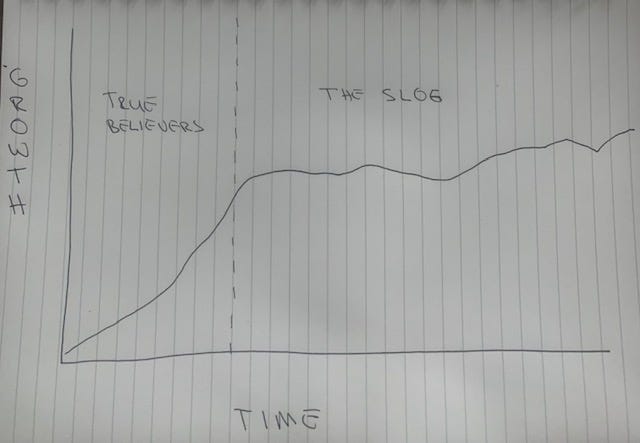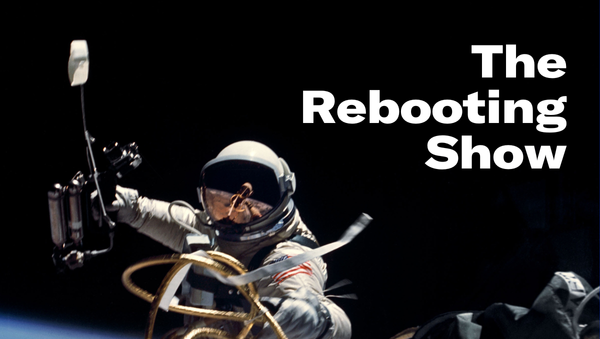Hitting the wall
Hot Vax Summer means attention is hard to come by
Welcome to this week’s edition of The Rebooting. If you aren’t a subscriber, please sign up to get The Rebooting every Wednesday morning.
This week, I wrote about how many publications, particularly by individuals, are hitting a wall. For all the rocket ship growth charts shared on Twitter, the reality is growth is a slog. Success in publishing is more about persistence than vision. Let me know your thoughts by hitting reply.
Hitting the wall
Distance running comes with a unique feature known as “hitting the wall.” This is when the body is depleted of electrolytes, the needed means for the body to carry oxygen to muscles. Training helps put off the wall -- it’s better to burn fat for fuel -- but the wall is a fact of life for running any distance of the marathon or longer. The physical effects of the wall include fatigue, sluggishness, mental confusion, even apathy and negativity. Successful runners accept that reality and simply muddle through. As a renowned ultra runner once put it, “It never always gets worse.”
This summer, many in digital publishing are hitting the wall. The effects of this wall: post-pandemic fatigue, slowed growth, uncertainty, even apathy. Like in running, this too is inevitable. We tend to celebrate the exceptions to the norm, the people who strike a chord and see growth take off with a squiggly line up and to the right -- or that’s how it looks in the Substack analytics screenshots shared on Twitter. For most people, this isn’t reality. Growth isn’t a hockey stick but a plateauing with, ideally, mostly steady progress.

This is coming into sharp relief this summer. Partisan news sources are seeing the inevitable Trump slump as Biden makes politics boring again. This is exacerbated by the emergence from the collective Covid bubble. Life in most of the country is returning to normal. People are traveling again. Lockdowns created something of an attention bubble to go along with the government-created asset bubble. Now, as Hot Vax Summer gets into full swing, attention is much harder to come by. With the asset bubble, many Robinhood users dipping in and out of meme stocks -- sorry, stonks -- came to the conclusion they were modern-day Gordon Gekkos. The truth is it’s hard to be a bad investor in an insane bull market.
The burgeoning “creator economy” -- not ready to embrace it fully without the scare quotes -- is hitting the wall, as the days of easy growth end. Burnout is common. Being solo has many upsides, not least in far better economics, but it comes at a cost of having to handle so many things and not having a team to cover up for your shortcomings. If you're solo, you can’t have a bad day (even though you will).
There’s also simple math at play. People can only subscribe to so many newsletters, take out memberships at so many publications. I’ve always believed that every brand has a certain number of true believers. These are people who will click or sign up for whatever you put in front of them. The number is different for each brand. But inevitably, all brands run out of true believers. That’s when the hard work begins, the unglamorous daily grind of eking out small wins and focusing on the details that drive incremental gains. There are no hacks or shortcuts on offer.
When new marathoners ask how to deal with hitting the wall, I don’t have much of a satisfying answer. The most important thing is to recognize the wall as a brain response vs being purely physical. That means you can force yourself to not feel sorry for yourself since, after all, nobody forced you to run that far and a pity party won’t get you to the finish line and let you sit down. The best tactical approach is to narrow your focus to what’s in front of you, not the idea that you still have six miles to go and are in a world of hurt. And bit by bit, you find your way through.
Dao watch
DAOs (decentralized autonomous organizations) are one of the most fascinating aspects of crypto, holding the promise of changing the dynamic between owners, creators and audiences. Crypto publication Decrypt is experimenting with DAOs in order to allow its audience to have a say in the content Decrpt produces. So holders of a Decrpt reader token -- earned by reading and sharing articles -- were allowed to vote on which educational guide Decrpt should next produce. This is all very early, but it holds a lot of promise of narrowing the gap between producers and their audiences.
The jobs opportunity
The jobs board has long been a source of frustration for me. On the surface, they hold so much promise for niche publications, particularly those focused on business sectors. And yet at Digiday we were never able to make much money off the board. Pallet has an interesting approach that enlists niche creators with job listings they curate for their audiences. For example, meme-heavy finance newsletter Litquidity just launched a jobs section. Labor shortages are going to be a fixture in the economy for a while to come. And anyone who has hired knows well the shortcomings of the big boards -- one candidate from LinkedIn declared they “don’t think outside the box; I stand on top of the box.” -- and niche brands can help. Pallet is still in beta but claims to have driven 20,000 job applications.
Relearning the platform lesson (again)
Most things in life involve tradeoffs. It seems publishers must learn this lesson time and again with platforms. The influx of investments into creator tools and platforms is great to see, yet no publisher -- whether an individual creator or a larger entity -- should be confused that the tradeoff of using these tools is often a lack of control, whether that’s finding your newsletter shut off from Substack for some violation, lack of technical support, or platform “creator funds” that turn into sharecropping.
Local: All hard, all the time
Jeff Jarvis has a data-filled walk through the numbers that show, again, that the demise of newspaper business models aren’t solely at the hands of the platform boogeymen. This is a fight that should simply fade away. The need for local news is more pressing than ever. The Surfside building collapse happened two miles from my home, and I’ve relied on the Miami Herald to follow the developments. Yet it’s hard for me to see newspapers as the primary answer to this puzzle. New models are needed. 6am, Axios and others are showing signs of success, but they’ll need to have enough heft to be able to do a credible job when unfortunate events like a building collapse happen in their cities.




